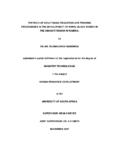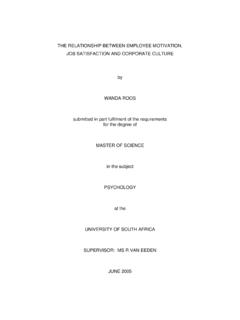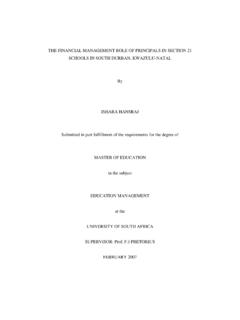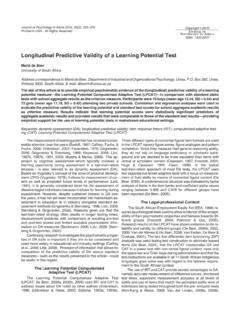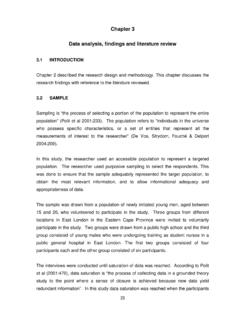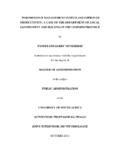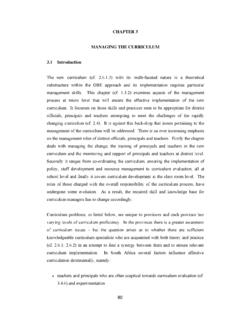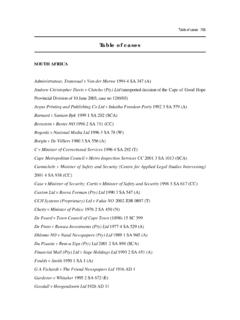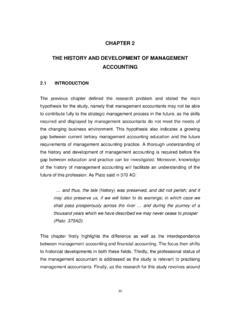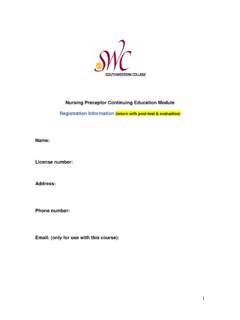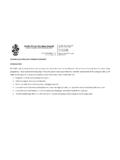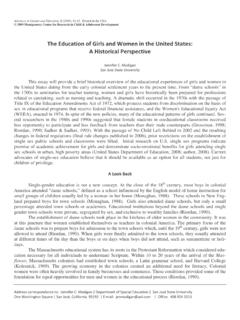Transcription of CHAPTER 3 RESEARCH DESIGN AND METHOD 3.1 …
1 61. CHAPTER 3. RESEARCH DESIGN AND METHOD . INTRODUCTION. In this CHAPTER the researcher explains how the RESEARCH study was conducted. A quantitative, descriptive study was conducted to determine: how computer assisted instruction was applied at the time of data collection the benefits of computer assisted instruction and computer-based learning for the learners the problems that the learners encountered during computer-based learning. The views of second and third year learners of a nursing college in the Gauteng Province of South Africa were obtained, by administering a structured questionnaire.
2 The entire population was involved in the study. Data collection elicited descriptive data, which were submitted to descriptive statistical analysis. The Mann-Whitney U-test was performed to determine whether differences existed between the responses of the second and those of the third year learners. The researcher employed various measures to enhance data quality. She ensured that the ethical principles of RESEARCH were complied to. RESEARCH DESIGN . A RESEARCH DESIGN is the overall plan for obtaining answers to the questions being studied and for handling some of the difficulties encountered during the RESEARCH process (Polit & Beck 2004:49).
3 RESEARCH designs are developed to meet the unique requirements of a study. According to De Vos (1998:123) a RESEARCH DESIGN is a blueprint or a detailed plan for how a RESEARCH study is conducted. Polit and Beck (2004:209), and Wood and Haber (1998:157) indicated that selecting a good RESEARCH DESIGN should be guided by an overarching consideration, namely whether the DESIGN does the best possible job of providing trustworthy answers to the RESEARCH question. 62. To achieve the RESEARCH objectives and to address the RESEARCH problem the researcher conducted quantitative RESEARCH . A quantitative RESEARCH generates quantifiable data.
4 It is primarily concerned with observable and measurable phenomena involving people, events or things, and establishing the strength of the relationship between variables, usually by statistical tests (Couchman & Dawson 1995: 40). A quantitative RESEARCH lends itself to investigating phenomena that require precise measurement and quantification often involving a rigorous and controlled DESIGN (Polit & Beck 2004:729). A quantitative DESIGN tends to be fairly structured to enhance objectivity. A quantitative RESEARCH primarily rests upon numbers aggregated into statistics, to enable the researcher to interpret obtained data and reach conclusions (Cormack 1996:113).
5 The features of this RESEARCH study are in accordance with the quantitative RESEARCH paradigm. Its focus was concise and narrow. The researcher exercised control by enhancing the external validity of the study. She utilised a structured questionnaire, which enabled her to quantify the responses and to conduct statistical analysis. The researcher maintained objectivity through structured data collection. Furthermore, an in-depth literature review, which served as a basis for the development of the data-collection instrument, was conducted. According to Wood and Haber (1998: 157), objectivity in the conceptualisation of the problem is derived from a review of the literature and the development of a theoretical framework.
6 A literature review enables the researcher in assessing the depth and breadth of available knowledge concerning the RESEARCH problem. In this present study, the researcher considered the most suitable RESEARCH DESIGN to be a non- experimental, univariate, and descriptive survey DESIGN . The term survey can be used to designate any RESEARCH activity in which the investigator gathers data from a portion of a population for the purpose of examining the characteristics, opinions or intentions of that population (Couchman &. Dawson 1995: 70; Polit & Beck 2004:234). A descriptive DESIGN is selected because of its high degree of representativeness and the ease in which a researcher could obtain the participants'.
7 Opinion (Polit & Beck 2004:50). In this present study, the researcher obtained and described the views of the respondents with regard to the nature of their exposure to computer assisted instruction, the benefits of this exposure, and the problems that they experienced while they were engaged in computer-based learning. The focus of this study was on a single variable, namely certain views. When very little is known about a topic or to explore a RESEARCH question, a descriptive DESIGN is applied. Within the context of this RESEARCH , the views of nursing learners on computer assisted instruction and computer-based learning had not been documented before at the selected nursing college.
8 In descriptive RESEARCH the RESEARCH variable is examined, as it exists without investigator 63. interference. Control over the RESEARCH setting is limited (Brink & Wood 1998: 289-291, Burns &. Grove 2001:201). In this study there was no manipulation of variables and the researcher did not attempt to control the RESEARCH setting. However, the data collection conditions were standardised to enhance data quality. RESEARCH METHOD . The RESEARCH METHOD is discussed by referring to sampling, data-collection and data-analysis. Population and sampling Polit and Beck (2004:289) define a population as the entire aggregation of cases that meet a designated set of criteria.
9 The target population is the aggregate of cases about which the researcher would like to make generalisations (Polit & Beck 2004:290). The target population for this present study was second and third year nursing learners following the 4-year Diploma Programme Leading to Registration as a Nurse (General, Psychiatric and Community) and Midwife, at a nursing college in the Gauteng Province of South Africa. They had been exposed to computer assisted instruction during their training and were required to draw upon those experiences to complete the questionnaire. All second and third year nursing learners willing to participate in this present study were included.
10 The reasons for involving the entire population was that it was of a manageable size, and that data was collected in a localised setting. Polit and Beck (2004:290) define eligibility criteria as the criteria that specify the characteristics that people in the population must possess, to be considered for inclusion in a study. The eligibility criteria for inclusion in the study under discussion were that they had to: be registered for the Diploma Programme Leading to Registration as a Nurse (General, Psychiatry and Community) and Midwife, at the specified nursing College be in their second or third year of study have been exposed to computer assisted instruction during the course of their studies.
